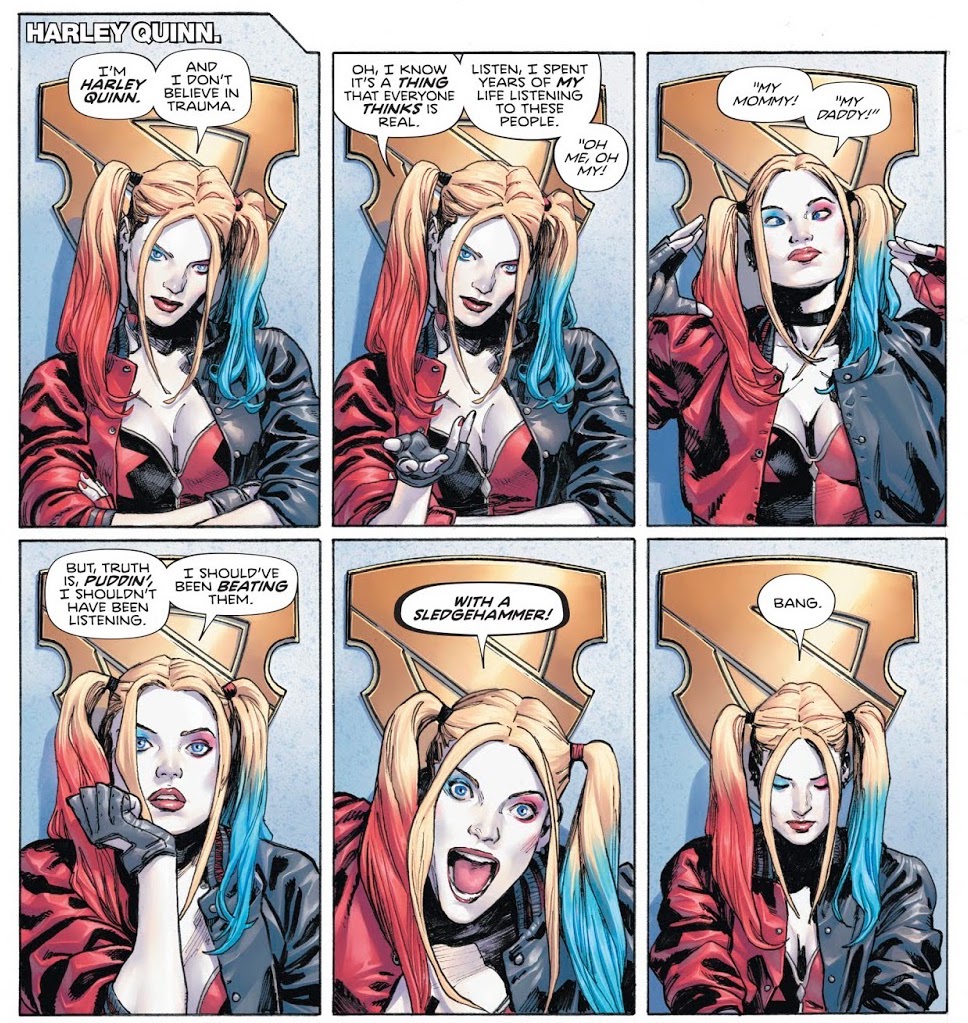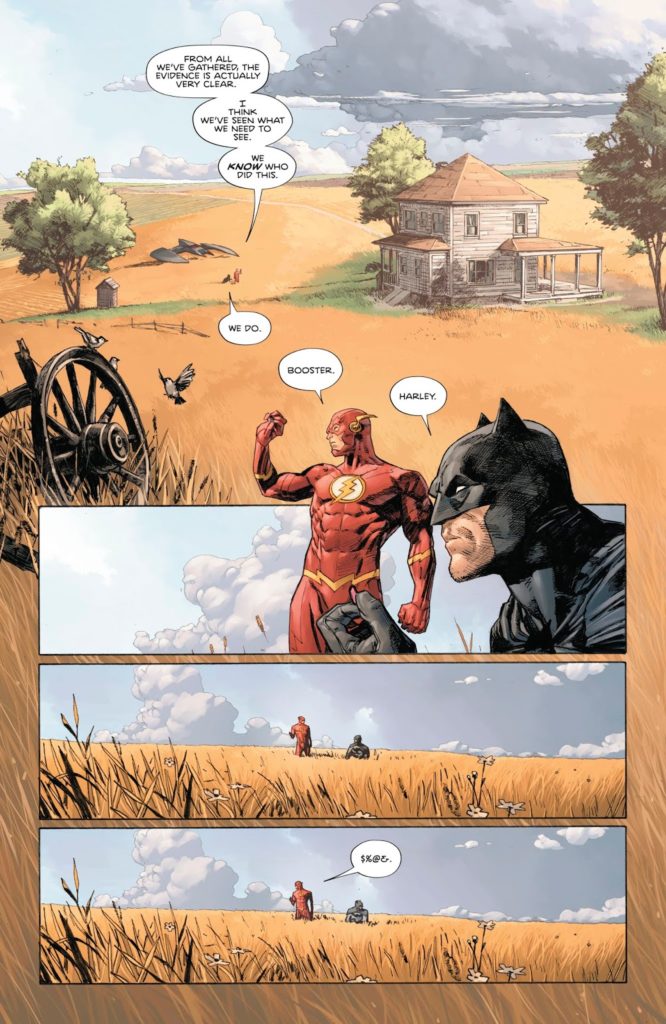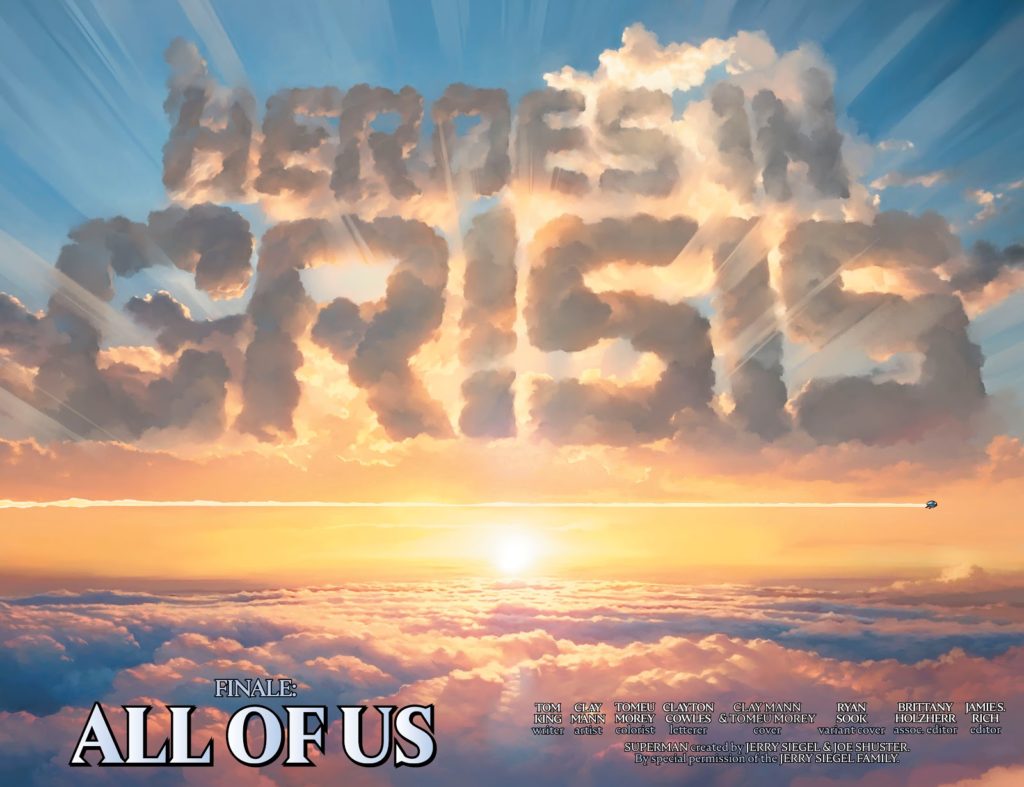I’ve talked on the podcast about the emotional rollercoaster that was Heroes in Crisis for me; I was underwhelmed, then slightly more whelmed, and back and forth — slightly more on the under side, admittedly — until a final issue that, at the time, felt as if it earned a lot of goodwill back merely by going for a sentimental, illogical fix that felt emotionally right, even if I could see why a million fans would disagree. So, when the collected edition ended up in my mailbox, I figured, why not read the whole thing in one sitting, and see how it holds up?
So, there’s some good news and some bad news.

The good news is that Heroes in Crisis worked a lot better for me on this read-through, for a number of reasons; the bad news is that many of those reasons center around the idea that — having read the series through before, I was less distracted by things like, “Failing to live up to preconceptions set by the work and its promotional material” this time around. That seems… kind of like a problem…?
Let’s get this out of the way first: Heroes in Crisis fails as a murder mystery, I think, not least of all because the murders are revealed to be manslaughters with some evidence tampering after the fact. Additionally, there’s the fact that the comic is an unreliable narrator, with the reader seeing two (equally untrue) interpretations of the deaths at different points in the series, in an attempt to misdirect the reader while also setting up the eventual reveal. (The comic is actually so unreliable that it’s still unclear to me after multiple readings whether an on-panel death in the third issue points to a last-minute rewrite of the big reveal, or else another purposeful misdirect that’s setting up the big reveal. That, too, is a problem.)

It’s also not, despite the way the book was marketed, a “big” story. Indeed, it’s almost obtusely the opposite — it’s purposefully internal and insular, and the eventual big reveal is literally, “I kept everything to myself and then when I didn’t, it killed everybody” — and, although the “trinity” of Superman, Batman and Wonder Woman appear, they’re far from the main characters of the book; indeed, Wonder Woman is barely present, which honestly feels like a mistake upon re-reading, if only to counter-balance the omnipresent maleness of the story. (It’s literally one where the phrase “Bros before Heroes” is used in two different, important, scenes.)
And yet… if you can divorce Heroes in Crisis from the context it was originally placed in — which it arguably places itself in, thanks to the fake-out of the murder mystery introduction — it’s a far better comic that it’s given credit for. Or, at least, that I was giving it credit for. There’s a subtlety at play in the writing that got lost in serialization, especially amid the expectations the series had at the time — knowing the end from the start, you can see that King actually lays clues and foreshadowing in place far earlier than it would seem; outside of the plot, there’s a lot of really nice character work, even if it can seem at odds with the way we expect some of those characters to act — and a surprising humor to the whole thing, as well, despite the obvious grimness of the whole thing.

(Re-reading this, I started to feel as if Tom King is a Marvel writer in some deep way; he writes characters as characters and eschews the good guy/bad guy dynamic that I think DC thrives on, to some extent. There’s a moral ambiguity and a need to portray everyone as flawed, rather than iconic, that feels as if it’s more suited to Marvel’s sense of mythology than DC’s. Which, of course, might be why he’s been so successful at DC. Never doubt the power of counter-programming.)
I feel like I should say something about the art, but I’m not sure what. Clay Mann is a strong superhero artist, and he draws really attractive figures that, for the most part, emote what King needs. There’s an element of female objectification throughout that’s distracting and, at times, overwhelms the moment that Mann should be selling, which is disappointing; Travis Moore is a capable fill-in to accompany Mann without the seams being obvious on some pages, and the other two artists — Lee Weeks and Mitch Gerads — are very good at what they do, and they do it capably. Yet, it’s not really an especially visual book, despite double page spreads for each title reveal that were clearly created with the intent of allowing Mann to show off. Honestly, the most notable thing about the visuals for Heroes in Crisis for me might be just how great Tomeu Morey’s colors are.

It remains a messy book, with moments where I read and thought, oh, really? even now, being more generous towards it. (Hello, the “She sent it 35 seconds ago” line, or Gnarrk quoting Keats in a full page splash.) It’s definitely overly ambitious, and could have benefited from a firmer editorial hand to keep it from losing focus. Yet, for a book about trauma and the pressure of living up to expectations — of, really, failing to live up to expectations, in many ways — it feels right, in some way, for it to be such a mess in the ways in which it’s a mess. It feels consistent, or coherent, perhaps. Right, in some way.
I’m glad I re-read it, and found new things to appreciate in it, but doing so also just made it particularly clear how Heroes in Crisis failed to measure up to what it appeared to be, when it first launched. How much that matters — how much it will matter to readers going forward, reading it separate from the pre-release hype of the original run — is, I suspect, something that will up to each and every individual reader’s personal preference. YMMV, as the kids once said, in other words.


Thanks for the review. I was waiting for the trade and still unsure whether I should get it. Your review comments on the flaws but it convinced me to get it. One thing that put me on the fence about it was the fact that they had tie ins and I didn’t want to get sucked into a drawn out cross over. Sounds like the tie ins are not integral to the mini. since you did not comment about them. Thanks for revisiting it and giving your thoughts.
It used to be that I couldn’t reconcile Tom King’s CIA background with the kind of writing he does, which is too flowery and pretentious to fit the usual War on Terror jingoism you’d think a person who went to Iraq and didn’t come back critical of America would show. Now I realize that King’s work isn’t the overtly conservative kind of neo-liberalism that characterizes Republicans, but the progressive yet lawful kind of neo-liberalism that characterizes Centrist Democrats, where there’s an acknowledgement of problems but without the depth or nerve to actually examine why there are problems. The kind that puts “#Resistance” on everything and sees sending drones instead of live humans overseas to kill people as a good enough improvement. The kind that looks back on the Iraq War with the “It’s Complicated” acknowledgement but no actual stance against the administrations in the country (such as, y’know, the CIA) that helped engineer the humanitarian catastrophes.
Heroes in Crisis is a good example, not just because it’s total shit, but because it involves a superhero accidentally murdering a shitload of other heroes then covering it up but ultimately being redeemed because He’s Sorry..
That is an absolutely fascinating line of thought. Thank you. I won’t read this until it’s on DC Universe, but when I do, I think I will try to bear in mind that on some level it parallels a certain respectable-moderate way of coping with the memory of the Iraq War.
But isn’t that also very central to superheroes? That kind of centrism has a deep and abiding faith in the essential redemptive goodness of America (“despite its flaws”), and isn’t that something that comes up over and over again with superheroes, who are among other things symbols of American power?
Incidentally, this comment box is being weird. Giant cursor, tiny letters. I hope this looks OK when I hit “Post Comment.”
Voord, you’re absolutely right that this is nothing new to the genre, especially not in the past 15 years. There’s always been a reactionary element to superhero comics, from the days when a rich boy used the money of stolen labor to fund his vigilante crusade. There’s always been a neoliberal worship of the status quo in superhero comics, that prides itself on the illusion of change but never takes its properties away from their most profitable incarnation for any meaningful length of time. Pair them with 2000s and 2010s worship of damaged white men as peak culture, and it’s not hard to see how this all comes together to having heroes do terrible things but it’s okay because they had good intentions. Unlike Tony Stark or Scott Summers, of course, nobody engineering the Iraq War had those good intentions, and the consequences faced by those characters are still much lighter than the real Bush administration (unless Cheney is going to delete his brain at some point in the near future).
Tom King’s own politics, as far as I can see on Twitter and in his comics, are this politics of denial. He’ll do a series like Omega Men where he’ll try to make a Both Sides metaphorical argument about the Iraq War with Kyle Rayner as America apparently stumbling good-natuiredly into the quagmire, and he’ll do a series like Sherriff of Babylon about a hero cop in that setting (even if the setting was admirably researched). As far as actually political commentary, I haven’t seen anything deeper than the usual Orange Man Bad comments, which seem more about the aesthetics of Trump than the material human costs (which would involve having to admit that Trump is the natural conclusion of all the American cultural trends of the past thirty years, and admitting that maybe the Company had a part in those)
These are all really salient points.
I’d add that although superhero comics have always been about maintaining the status quo, that’s not really neoliberal as such. Rather, neoliberalism is (or at least until recently was) the status quo, and comics just reflect this; so do most forms of popular entertainment. The question for me then isn’t whether most comics reflect the status quo, cultural hegemony, or whatever we want to call it, but rather why I find King’s comics so noxious. And I think my answer is one that I’m a little ashamed of. Namely, my knowledge that he volunteered for the CIA after 9-11 and went to middle east at a time when everyone, everyone I knew with a scintilla of political awareness understood that the US was wrong to do so makes me totally uninterested in his view on anything. And the fact that he’s using characters that I might otherwise want to read about to rationalize his participation in an organization that tortured and killed its way to no particular end. That he continues to tout that participation when promoting his work makes me totally unable to take him seriously as an intellectually or morally honest person. This, in turn, puts me off his comics to the extent they serve as a filter for his own trauma (see Mister Miracle).
Well, maybe sitting in that cubby in the green zone and seeing such brave men and women come back missing limbs and friends gave him a really good idea for a Darkseid story.
(And I’m pretty sure King wasn’t using Darkseid as a metaphor for Halliburton)
Your comments and insight are savage and I love them.
I will always believe that the Sanctuary A.I. was supposed to be the villain originally. I think DC got cold feet about implicating the Trinity as accidentally causing a massacre because of their hubris and King had to rewrite halfway through the series (Issue 4 is the point the story starts losing control.) I also think the reaction to the Wedding issue contributed to this course change.
Its an interesting, sloppy, horribly compromised work. It doesn’t work as a murder mystery or as a meditation on trauma overall. It spins its wheels for three issues in the middle until we find out Wally West did it. It does have impressive moments.
I can understand King going to 12 issue stories only after doing a long-form run that got clipped and an event that got kneecapped probably before the first issue was out.
I read this tonight and while it wasn’t as horrible as its reputation, it was such a mess my reaction to it was “This is a story only Graeme MacMillan could enjoy”
and what do you know, you did. The Party Must Be Protected.